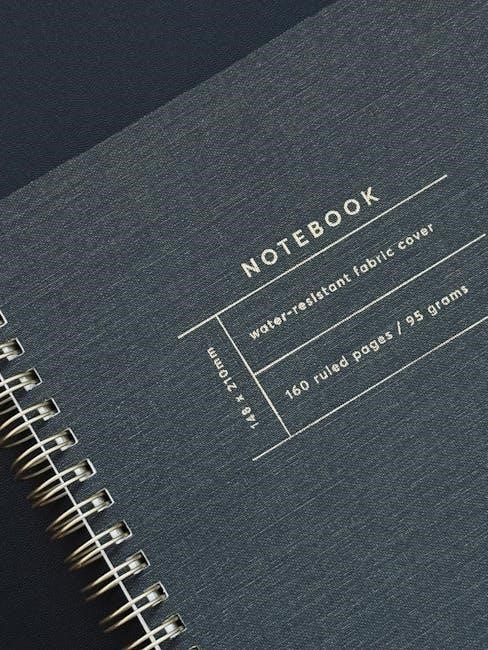Understanding journal sizes is essential for selecting the right notebook for your needs‚ ensuring a balance between portability‚ comfort‚ and functionality for optimal writing experiences.
Why Journal Size Matters
Journal size significantly impacts the user experience‚ influencing portability‚ comfort‚ and functionality. A journal that is too large may be cumbersome to carry‚ while a smaller size offers convenience for daily use. Comfort is crucial‚ as a journal that fits well in the hand encourages extended writing sessions. Functionality varies with size‚ making certain dimensions better suited for specific tasks like sketching or quick notes. Personal preference also plays a role‚ as some prefer ample space for creativity‚ while others value compactness. Ultimately‚ the right size enhances the journaling experience‚ ensuring it meets individual needs for practicality and enjoyment. Size truly shapes how and where journals are used.
Key Considerations: Portability‚ Comfort‚ and Functionality
When selecting a journal size‚ portability‚ comfort‚ and functionality are key considerations. Portability ensures the journal can be easily carried in bags or pockets‚ making it accessible anywhere. Comfort relates to how well the journal fits in the hand and how enjoyable it is to write or draw in it. Functionality depends on the size’s suitability for tasks like sketching‚ note-taking‚ or daily planning. Balancing these factors is crucial‚ as a journal that’s too large may lack portability‚ while a small one might restrict creativity. Each size offers unique benefits‚ so understanding these aspects helps in choosing the ideal journal for specific needs and preferences.
Standard Journal Sizes
Standard journal sizes include A5‚ B5‚ and A4‚ each offering distinct dimensions and benefits to suit various needs‚ from portability to ample writing space for creativity and productivity.
A5 Journal Size
The A5 journal size measures 5.8 x 8.3 inches (148 x 210 mm)‚ making it a popular choice for its balance of portability and writing space. Its compact dimensions allow it to fit easily into bags or backpacks‚ while still providing ample room for notes‚ sketches‚ or creative projects. A5 journals are widely used for daily journaling‚ bullet journaling‚ and even as sketchbooks. Their versatility and ergonomic design make them a favorite among journal enthusiasts. Whether for personal reflection‚ artistic expression‚ or professional note-taking‚ the A5 size is a practical and versatile option that suits a variety of needs and preferences.
B5 Journal Size
The B5 journal size measures 6.93 x 9.84 inches (176 x 250 mm)‚ offering a larger writing area compared to A5 while maintaining portability. This size is ideal for those who need more space for detailed notes‚ sketches‚ or creative projects. B5 journals are often preferred by professionals and artists‚ as they provide a generous canvas without being overly bulky. Despite its larger dimensions‚ the B5 size is still compact enough to carry in a bag or briefcase‚ making it a practical choice for both everyday use and specialized tasks. Its balanced proportions ensure comfort and efficiency for various journaling purposes and creative endeavors.
A4 Journal Size
The A4 journal size measures 8.27 x 11.69 inches (210 x 297 mm)‚ making it one of the largest standard journal sizes available. Its spacious layout is ideal for detailed note-taking‚ sketching‚ or organizing complex projects. A4 journals are commonly used in professional settings and by creatives who require ample writing and drawing space. While less portable than smaller sizes like A5 or B5‚ the A4 size offers unparalleled versatility for tasks that demand more room. Its widespread use in offices and artistic communities highlights its practicality and effectiveness for both functional and creative purposes‚ making it a favorite among professionals and enthusiasts alike.

Popular Journal Sizes
Popular journal sizes include A6‚ B6‚ and A5‚ each offering unique benefits. A6 is compact for travel‚ while B6 balances portability and writing space‚ suiting various needs.
A6 Journal Size
The A6 journal size measures approximately 4.1 x 5.8 inches (105 x 148 mm)‚ making it highly portable and ideal for carrying in pockets or small bags. Its compact dimensions are perfect for quick notes‚ travel logs‚ or daily planners. A6 journals are great for shorter entries‚ jotting down ideas‚ or maintaining a concise journaling practice. They are also versatile‚ serving as pocket diaries‚ mini-log books‚ or shopping list notepads. Their small size ensures they are not overwhelming‚ making them a favorite for those who prefer a neat and tidy journal that’s easy to handle on the go.

B6 Journal Size
The B6 journal size measures approximately 4.9 x 6.9 inches (12.6 x 17.6 cm)‚ offering a balance between portability and writing space. It is slightly smaller than A5 but larger than A6‚ making it ideal for everyday use. B6 journals are popular for personal journals‚ sketchbooks‚ and bullet journaling due to their compact yet spacious layout. They are lightweight and easy to carry in bags or backpacks‚ ensuring accessibility wherever you go. This size is particularly favored for its ergonomic design‚ providing comfort during extended writing sessions. B6 journals strike a perfect balance between practicality and creativity‚ catering to diverse journaling needs and preferences.

Evolution of Journal Sizes
Journal sizes originated from standardized paper dimensions introduced in Germany in the 1920s‚ evolving into global norms by the 1970s‚ with regional variations emerging over time.
History of Standardization
The standardization of journal sizes began in Germany in the 1920s‚ introducing the A-series dimensions to create consistency in paper formats. By the 1970s‚ these A-series sizes became globally adopted‚ ensuring uniformity across industries. The A-series‚ including A4‚ A5‚ and A6‚ was designed to maintain aspect ratios‚ allowing easy scaling. B-series sizes emerged later to fill gaps between A-series dimensions‚ offering additional options for specific needs. While A-series remains the global standard‚ B-series sizes are widely used‚ particularly in regions like the United States and Japan‚ adapting to cultural preferences and practical requirements. This evolution reflects the global adaptation of standardized journal sizing.
Global Adoption and Variations
Despite the A-series being a global standard‚ variations exist across regions. The B-series‚ while not universally standardized‚ is widely adopted‚ especially in the US and Japan‚ offering sizes like B5 and B6. Europe predominantly uses A-series sizes‚ with A4 and A5 being most common. In contrast‚ North America often opts for letter-sized formats‚ though A-series is gaining popularity. This diversity reflects cultural preferences and practical needs‚ ensuring journals cater to different lifestyles and requirements worldwide‚ while maintaining a balance between functionality and portability for varying user demands and preferences in journaling and professional use.

Choosing the Right Journal Size
Selecting the ideal journal size involves balancing portability‚ writing space‚ and personal preference‚ ensuring it meets your lifestyle and journaling needs effectively and efficiently always.
Portability vs. Writing Space
When deciding on a journal size‚ portability and writing space are key factors; Smaller sizes like A6 and B6 offer ease of carrying‚ ideal for quick notes and travel. Larger sizes‚ such as A5 and B5‚ provide more writing space‚ making them suitable for detailed journaling or sketching. A4 journals are best for desktop use‚ offering ample room but compromising on portability. Balancing these aspects ensures your journal fits your lifestyle‚ whether you’re on-the-go or prefer a dedicated space for creative expression. The right size enhances your journaling experience‚ making it both practical and enjoyable. Choose wisely based on your needs.
Personal Preference and Journaling Needs
Choosing a journal size often comes down to personal preference and specific journaling needs. Some prefer smaller sizes like A6 or B6 for their compactness‚ ideal for quick entries or travel logs. Others opt for larger formats‚ such as A5 or B5‚ to accommodate detailed writing‚ sketches‚ or creative projects. A4 journals are great for those who need expansive space for art or planning. Consider how you intend to use your journal—whether for daily reflection‚ artistic expression‚ or practical planning—and select a size that aligns with your unique habits and goals. Your journal should feel like a natural extension of your creative or organizational process‚ enhancing your overall experience. Tailoring your choice to your preferences ensures a more enjoyable and effective journaling practice. Selecting the right size can make a significant difference in how you engage with your journal‚ fostering productivity and creativity. By aligning your journal size with your personal needs‚ you create a tool that complements your lifestyle and supports your goals‚ whether they are artistic‚ organizational‚ or reflective in nature.
Creative vs. Practical Use Cases
Journals cater to both creative and practical needs‚ with size playing a crucial role in their use. Larger formats like A4 or B5 are ideal for artistic expression‚ offering ample space for sketches‚ mixed media‚ or detailed planning. Smaller sizes‚ such as A6 or B6‚ are perfect for practical tasks like bullet journaling‚ to-do lists‚ or quick notes. Choosing the right size ensures your journal meets your specific requirements‚ whether you’re creating art‚ organizing tasks‚ or documenting memories. Balancing creativity and functionality‚ the size of your journal should reflect how you intend to use it‚ making it a versatile tool for both inspiration and organization.
Journal Size Comparison Chart
This chart provides a clear overview of popular journal sizes‚ helping you make an informed choice. The A5 size (5.8 x 8.3 inches) is the most common‚ offering a balance of portability and writing space. The B5 (7.2 x 10.1 inches) is slightly larger‚ ideal for detailed notes or sketches. A4 (8.27 x 11.69 inches) is best for expansive projects‚ while A6 (4.1 x 5.8 inches) and B6 (4.9 x 6.9 inches) are compact for on-the-go use. Each size caters to different preferences‚ ensuring there’s a perfect fit for every need. Use this chart to compare dimensions and select the size that suits your journaling style.